Reflective Essay: Healthcare Experience and Patient Care
VerifiedAdded on 2020/03/04
|11
|3418
|64
Essay
AI Summary
This reflective essay details a healthcare professional's experience caring for a terminally ill patient, Anne, who suffered from breast cancer. The essay explores the emotional, physical, and spiritual challenges faced by the patient and her family during the end-of-life journey. It discusses the caregiver's role in providing comprehensive support, including effective communication strategies, pharmacological and non-pharmacological treatments, and ethical considerations. The essay highlights the importance of palliative care, the changing patterns of mortality, and the need for community-based support to ensure a dignified and meaningful end-of-life experience. It emphasizes the significance of providing comfort, managing pain, and respecting the patient's wishes while addressing their physical, emotional, and spiritual needs. The essay also touches upon the importance of advanced directives, the role of healthcare professionals, and the use of both verbal and non-verbal communication to help the patient and their family during this difficult time.
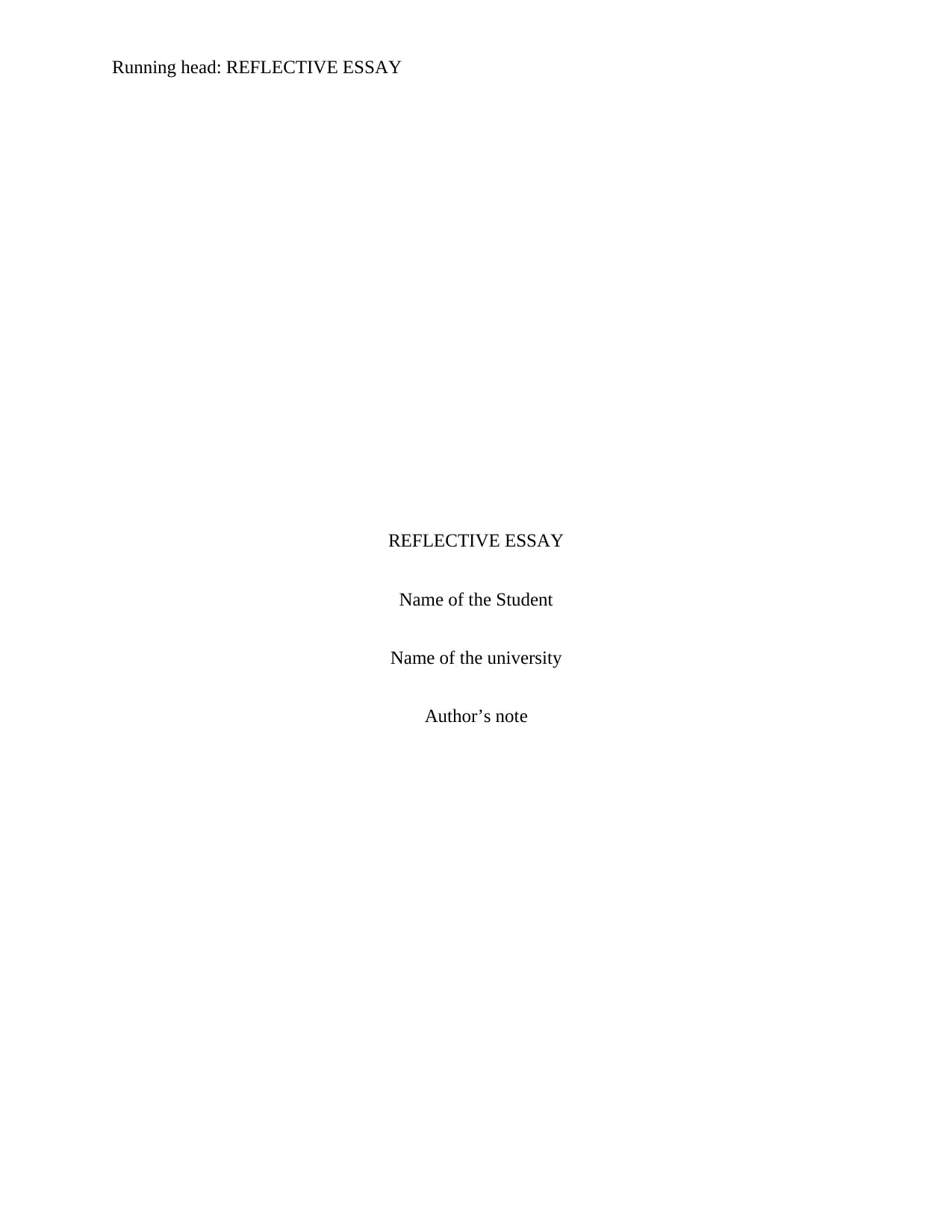
Running head: REFLECTIVE ESSAY
REFLECTIVE ESSAY
Name of the Student
Name of the university
Author’s note
REFLECTIVE ESSAY
Name of the Student
Name of the university
Author’s note
Paraphrase This Document
Need a fresh take? Get an instant paraphrase of this document with our AI Paraphraser
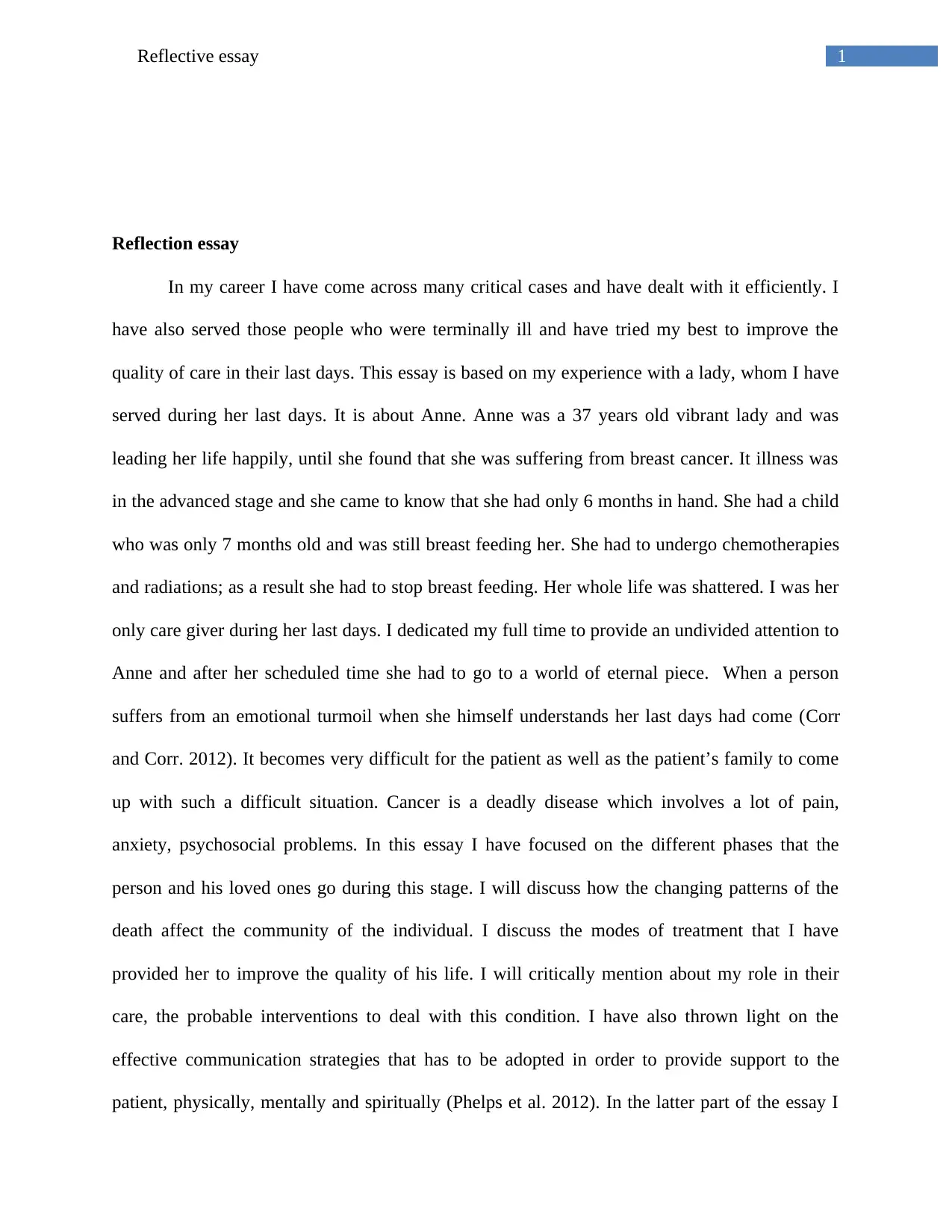
1Reflective essay
Reflection essay
In my career I have come across many critical cases and have dealt with it efficiently. I
have also served those people who were terminally ill and have tried my best to improve the
quality of care in their last days. This essay is based on my experience with a lady, whom I have
served during her last days. It is about Anne. Anne was a 37 years old vibrant lady and was
leading her life happily, until she found that she was suffering from breast cancer. It illness was
in the advanced stage and she came to know that she had only 6 months in hand. She had a child
who was only 7 months old and was still breast feeding her. She had to undergo chemotherapies
and radiations; as a result she had to stop breast feeding. Her whole life was shattered. I was her
only care giver during her last days. I dedicated my full time to provide an undivided attention to
Anne and after her scheduled time she had to go to a world of eternal piece. When a person
suffers from an emotional turmoil when she himself understands her last days had come (Corr
and Corr. 2012). It becomes very difficult for the patient as well as the patient’s family to come
up with such a difficult situation. Cancer is a deadly disease which involves a lot of pain,
anxiety, psychosocial problems. In this essay I have focused on the different phases that the
person and his loved ones go during this stage. I will discuss how the changing patterns of the
death affect the community of the individual. I discuss the modes of treatment that I have
provided her to improve the quality of his life. I will critically mention about my role in their
care, the probable interventions to deal with this condition. I have also thrown light on the
effective communication strategies that has to be adopted in order to provide support to the
patient, physically, mentally and spiritually (Phelps et al. 2012). In the latter part of the essay I
Reflection essay
In my career I have come across many critical cases and have dealt with it efficiently. I
have also served those people who were terminally ill and have tried my best to improve the
quality of care in their last days. This essay is based on my experience with a lady, whom I have
served during her last days. It is about Anne. Anne was a 37 years old vibrant lady and was
leading her life happily, until she found that she was suffering from breast cancer. It illness was
in the advanced stage and she came to know that she had only 6 months in hand. She had a child
who was only 7 months old and was still breast feeding her. She had to undergo chemotherapies
and radiations; as a result she had to stop breast feeding. Her whole life was shattered. I was her
only care giver during her last days. I dedicated my full time to provide an undivided attention to
Anne and after her scheduled time she had to go to a world of eternal piece. When a person
suffers from an emotional turmoil when she himself understands her last days had come (Corr
and Corr. 2012). It becomes very difficult for the patient as well as the patient’s family to come
up with such a difficult situation. Cancer is a deadly disease which involves a lot of pain,
anxiety, psychosocial problems. In this essay I have focused on the different phases that the
person and his loved ones go during this stage. I will discuss how the changing patterns of the
death affect the community of the individual. I discuss the modes of treatment that I have
provided her to improve the quality of his life. I will critically mention about my role in their
care, the probable interventions to deal with this condition. I have also thrown light on the
effective communication strategies that has to be adopted in order to provide support to the
patient, physically, mentally and spiritually (Phelps et al. 2012). In the latter part of the essay I
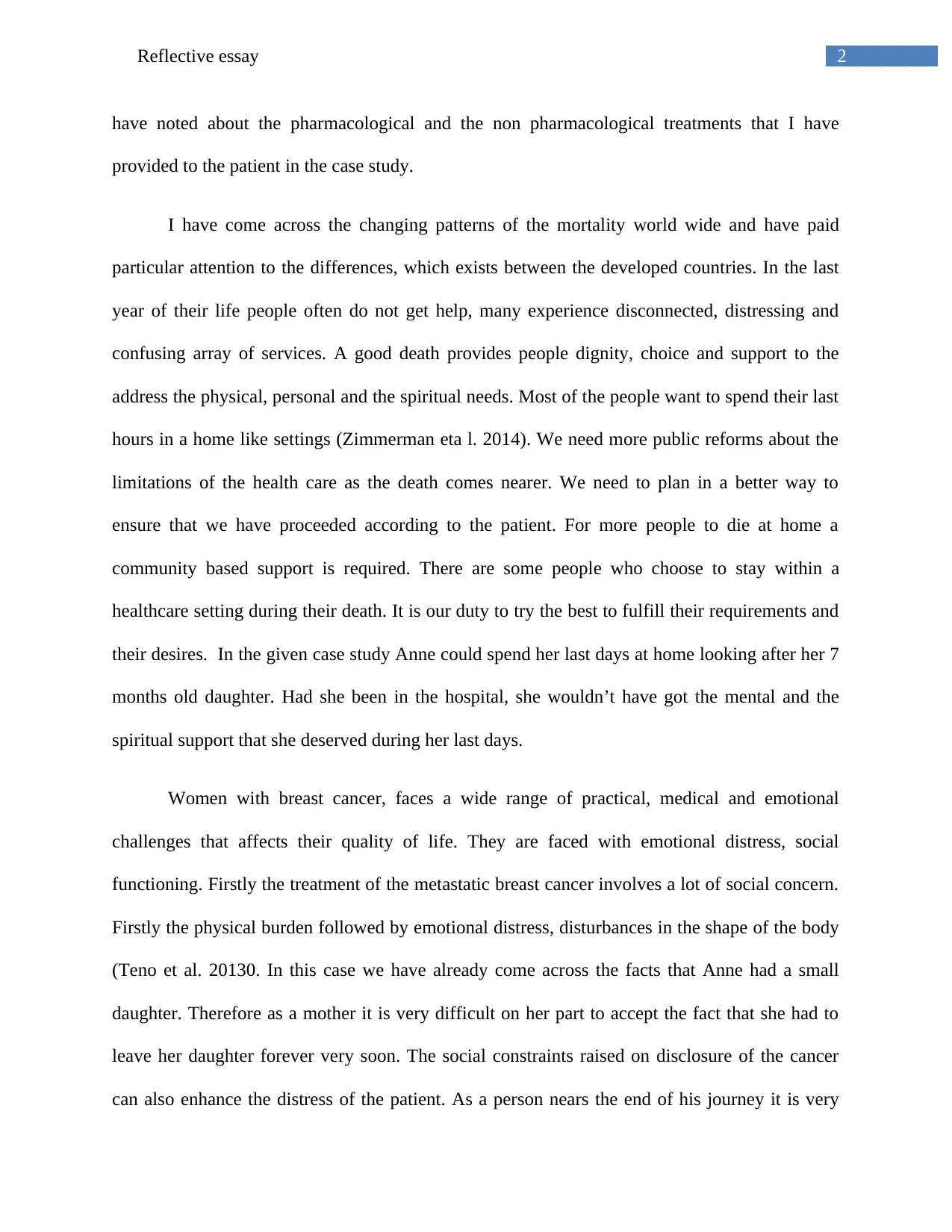
2Reflective essay
have noted about the pharmacological and the non pharmacological treatments that I have
provided to the patient in the case study.
I have come across the changing patterns of the mortality world wide and have paid
particular attention to the differences, which exists between the developed countries. In the last
year of their life people often do not get help, many experience disconnected, distressing and
confusing array of services. A good death provides people dignity, choice and support to the
address the physical, personal and the spiritual needs. Most of the people want to spend their last
hours in a home like settings (Zimmerman eta l. 2014). We need more public reforms about the
limitations of the health care as the death comes nearer. We need to plan in a better way to
ensure that we have proceeded according to the patient. For more people to die at home a
community based support is required. There are some people who choose to stay within a
healthcare setting during their death. It is our duty to try the best to fulfill their requirements and
their desires. In the given case study Anne could spend her last days at home looking after her 7
months old daughter. Had she been in the hospital, she wouldn’t have got the mental and the
spiritual support that she deserved during her last days.
Women with breast cancer, faces a wide range of practical, medical and emotional
challenges that affects their quality of life. They are faced with emotional distress, social
functioning. Firstly the treatment of the metastatic breast cancer involves a lot of social concern.
Firstly the physical burden followed by emotional distress, disturbances in the shape of the body
(Teno et al. 20130. In this case we have already come across the facts that Anne had a small
daughter. Therefore as a mother it is very difficult on her part to accept the fact that she had to
leave her daughter forever very soon. The social constraints raised on disclosure of the cancer
can also enhance the distress of the patient. As a person nears the end of his journey it is very
have noted about the pharmacological and the non pharmacological treatments that I have
provided to the patient in the case study.
I have come across the changing patterns of the mortality world wide and have paid
particular attention to the differences, which exists between the developed countries. In the last
year of their life people often do not get help, many experience disconnected, distressing and
confusing array of services. A good death provides people dignity, choice and support to the
address the physical, personal and the spiritual needs. Most of the people want to spend their last
hours in a home like settings (Zimmerman eta l. 2014). We need more public reforms about the
limitations of the health care as the death comes nearer. We need to plan in a better way to
ensure that we have proceeded according to the patient. For more people to die at home a
community based support is required. There are some people who choose to stay within a
healthcare setting during their death. It is our duty to try the best to fulfill their requirements and
their desires. In the given case study Anne could spend her last days at home looking after her 7
months old daughter. Had she been in the hospital, she wouldn’t have got the mental and the
spiritual support that she deserved during her last days.
Women with breast cancer, faces a wide range of practical, medical and emotional
challenges that affects their quality of life. They are faced with emotional distress, social
functioning. Firstly the treatment of the metastatic breast cancer involves a lot of social concern.
Firstly the physical burden followed by emotional distress, disturbances in the shape of the body
(Teno et al. 20130. In this case we have already come across the facts that Anne had a small
daughter. Therefore as a mother it is very difficult on her part to accept the fact that she had to
leave her daughter forever very soon. The social constraints raised on disclosure of the cancer
can also enhance the distress of the patient. As a person nears the end of his journey it is very
⊘ This is a preview!⊘
Do you want full access?
Subscribe today to unlock all pages.

Trusted by 1+ million students worldwide
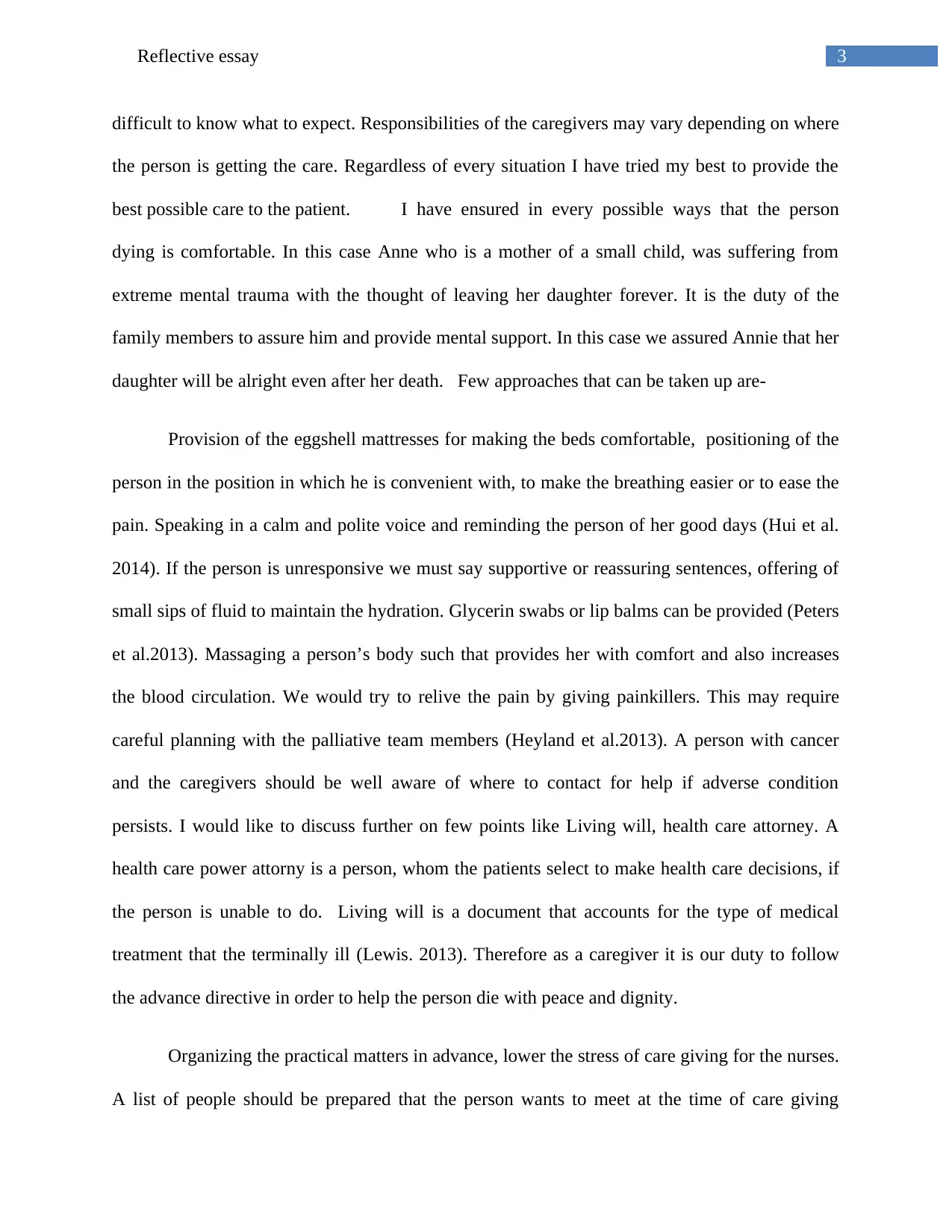
3Reflective essay
difficult to know what to expect. Responsibilities of the caregivers may vary depending on where
the person is getting the care. Regardless of every situation I have tried my best to provide the
best possible care to the patient. I have ensured in every possible ways that the person
dying is comfortable. In this case Anne who is a mother of a small child, was suffering from
extreme mental trauma with the thought of leaving her daughter forever. It is the duty of the
family members to assure him and provide mental support. In this case we assured Annie that her
daughter will be alright even after her death. Few approaches that can be taken up are-
Provision of the eggshell mattresses for making the beds comfortable, positioning of the
person in the position in which he is convenient with, to make the breathing easier or to ease the
pain. Speaking in a calm and polite voice and reminding the person of her good days (Hui et al.
2014). If the person is unresponsive we must say supportive or reassuring sentences, offering of
small sips of fluid to maintain the hydration. Glycerin swabs or lip balms can be provided (Peters
et al.2013). Massaging a person’s body such that provides her with comfort and also increases
the blood circulation. We would try to relive the pain by giving painkillers. This may require
careful planning with the palliative team members (Heyland et al.2013). A person with cancer
and the caregivers should be well aware of where to contact for help if adverse condition
persists. I would like to discuss further on few points like Living will, health care attorney. A
health care power attorny is a person, whom the patients select to make health care decisions, if
the person is unable to do. Living will is a document that accounts for the type of medical
treatment that the terminally ill (Lewis. 2013). Therefore as a caregiver it is our duty to follow
the advance directive in order to help the person die with peace and dignity.
Organizing the practical matters in advance, lower the stress of care giving for the nurses.
A list of people should be prepared that the person wants to meet at the time of care giving
difficult to know what to expect. Responsibilities of the caregivers may vary depending on where
the person is getting the care. Regardless of every situation I have tried my best to provide the
best possible care to the patient. I have ensured in every possible ways that the person
dying is comfortable. In this case Anne who is a mother of a small child, was suffering from
extreme mental trauma with the thought of leaving her daughter forever. It is the duty of the
family members to assure him and provide mental support. In this case we assured Annie that her
daughter will be alright even after her death. Few approaches that can be taken up are-
Provision of the eggshell mattresses for making the beds comfortable, positioning of the
person in the position in which he is convenient with, to make the breathing easier or to ease the
pain. Speaking in a calm and polite voice and reminding the person of her good days (Hui et al.
2014). If the person is unresponsive we must say supportive or reassuring sentences, offering of
small sips of fluid to maintain the hydration. Glycerin swabs or lip balms can be provided (Peters
et al.2013). Massaging a person’s body such that provides her with comfort and also increases
the blood circulation. We would try to relive the pain by giving painkillers. This may require
careful planning with the palliative team members (Heyland et al.2013). A person with cancer
and the caregivers should be well aware of where to contact for help if adverse condition
persists. I would like to discuss further on few points like Living will, health care attorney. A
health care power attorny is a person, whom the patients select to make health care decisions, if
the person is unable to do. Living will is a document that accounts for the type of medical
treatment that the terminally ill (Lewis. 2013). Therefore as a caregiver it is our duty to follow
the advance directive in order to help the person die with peace and dignity.
Organizing the practical matters in advance, lower the stress of care giving for the nurses.
A list of people should be prepared that the person wants to meet at the time of care giving
Paraphrase This Document
Need a fresh take? Get an instant paraphrase of this document with our AI Paraphraser
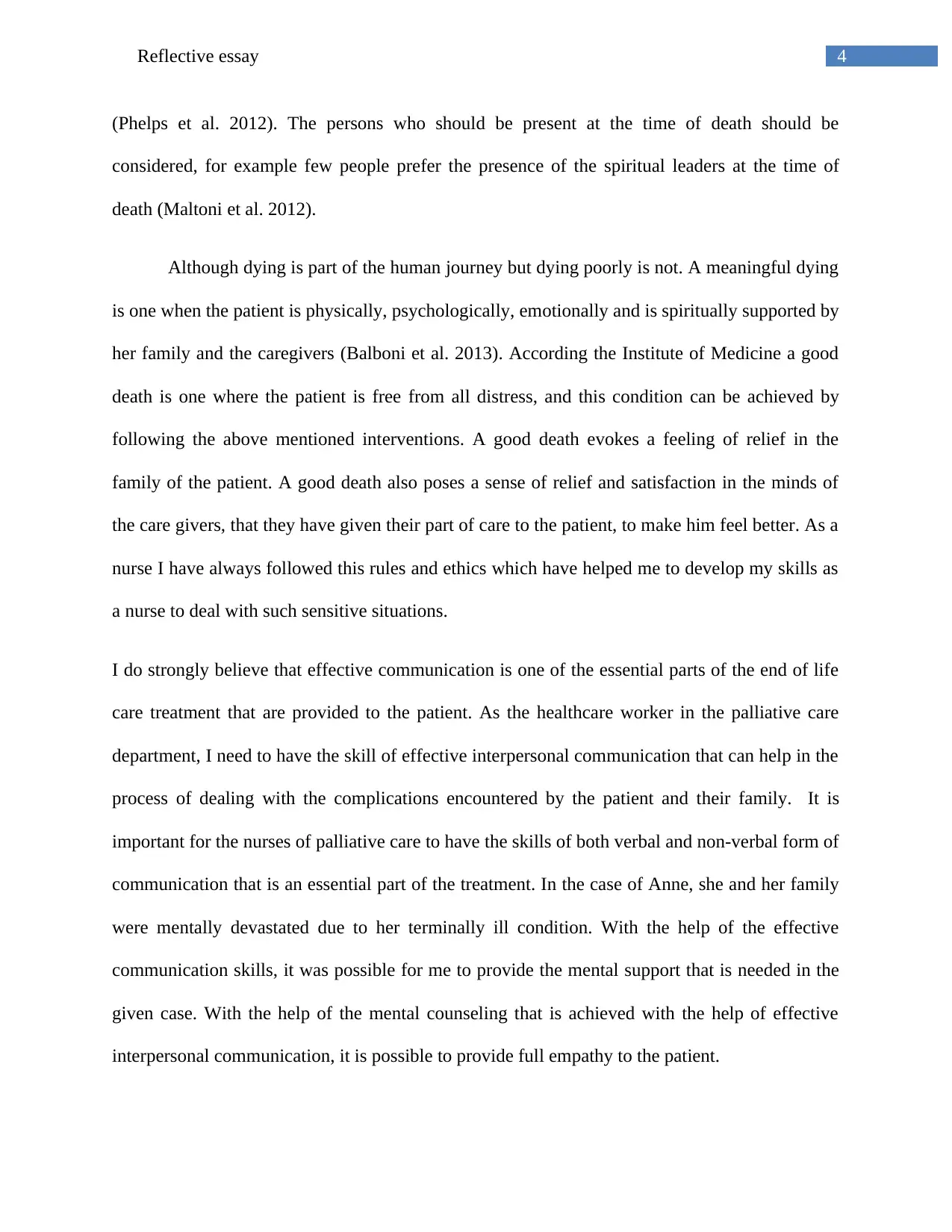
4Reflective essay
(Phelps et al. 2012). The persons who should be present at the time of death should be
considered, for example few people prefer the presence of the spiritual leaders at the time of
death (Maltoni et al. 2012).
Although dying is part of the human journey but dying poorly is not. A meaningful dying
is one when the patient is physically, psychologically, emotionally and is spiritually supported by
her family and the caregivers (Balboni et al. 2013). According the Institute of Medicine a good
death is one where the patient is free from all distress, and this condition can be achieved by
following the above mentioned interventions. A good death evokes a feeling of relief in the
family of the patient. A good death also poses a sense of relief and satisfaction in the minds of
the care givers, that they have given their part of care to the patient, to make him feel better. As a
nurse I have always followed this rules and ethics which have helped me to develop my skills as
a nurse to deal with such sensitive situations.
I do strongly believe that effective communication is one of the essential parts of the end of life
care treatment that are provided to the patient. As the healthcare worker in the palliative care
department, I need to have the skill of effective interpersonal communication that can help in the
process of dealing with the complications encountered by the patient and their family. It is
important for the nurses of palliative care to have the skills of both verbal and non-verbal form of
communication that is an essential part of the treatment. In the case of Anne, she and her family
were mentally devastated due to her terminally ill condition. With the help of the effective
communication skills, it was possible for me to provide the mental support that is needed in the
given case. With the help of the mental counseling that is achieved with the help of effective
interpersonal communication, it is possible to provide full empathy to the patient.
(Phelps et al. 2012). The persons who should be present at the time of death should be
considered, for example few people prefer the presence of the spiritual leaders at the time of
death (Maltoni et al. 2012).
Although dying is part of the human journey but dying poorly is not. A meaningful dying
is one when the patient is physically, psychologically, emotionally and is spiritually supported by
her family and the caregivers (Balboni et al. 2013). According the Institute of Medicine a good
death is one where the patient is free from all distress, and this condition can be achieved by
following the above mentioned interventions. A good death evokes a feeling of relief in the
family of the patient. A good death also poses a sense of relief and satisfaction in the minds of
the care givers, that they have given their part of care to the patient, to make him feel better. As a
nurse I have always followed this rules and ethics which have helped me to develop my skills as
a nurse to deal with such sensitive situations.
I do strongly believe that effective communication is one of the essential parts of the end of life
care treatment that are provided to the patient. As the healthcare worker in the palliative care
department, I need to have the skill of effective interpersonal communication that can help in the
process of dealing with the complications encountered by the patient and their family. It is
important for the nurses of palliative care to have the skills of both verbal and non-verbal form of
communication that is an essential part of the treatment. In the case of Anne, she and her family
were mentally devastated due to her terminally ill condition. With the help of the effective
communication skills, it was possible for me to provide the mental support that is needed in the
given case. With the help of the mental counseling that is achieved with the help of effective
interpersonal communication, it is possible to provide full empathy to the patient.
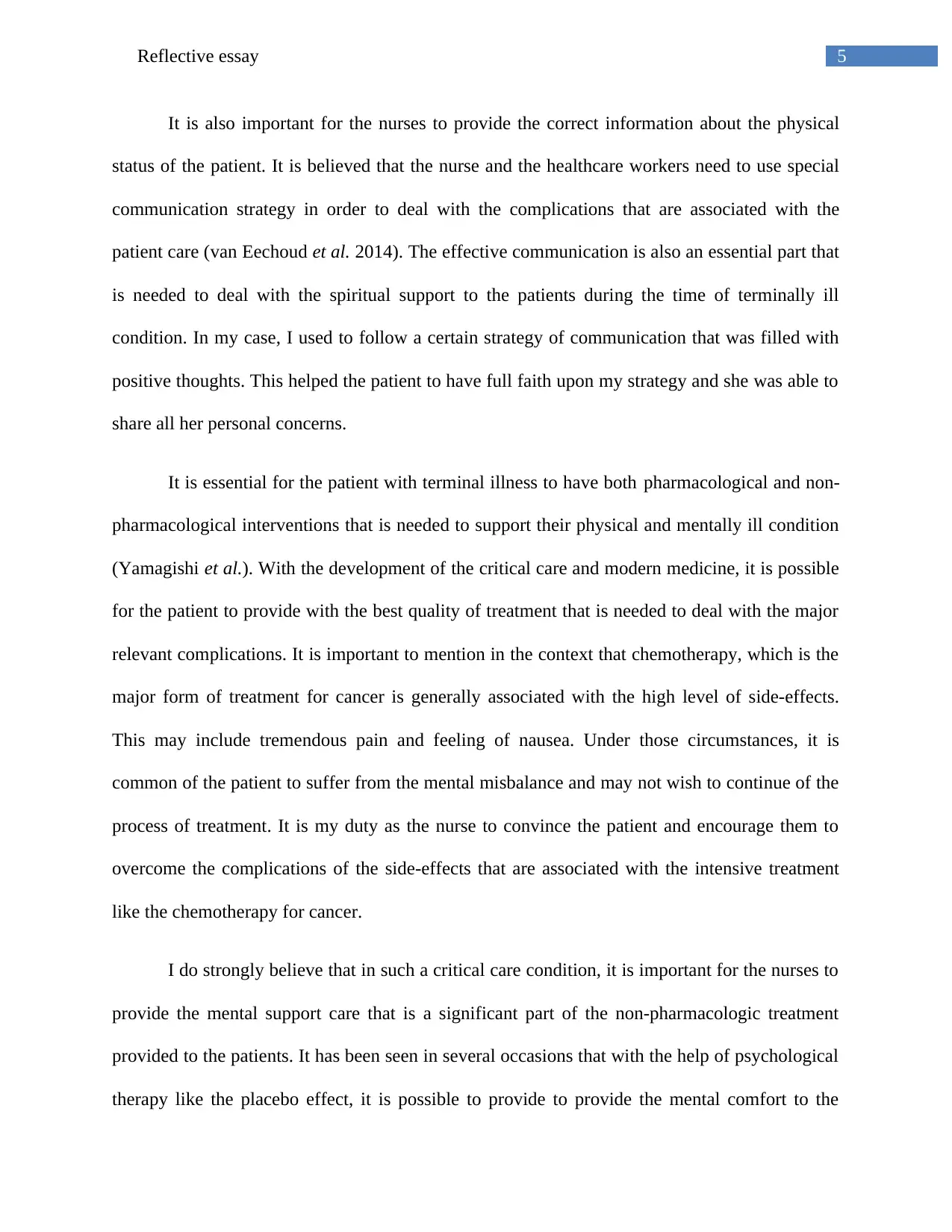
5Reflective essay
It is also important for the nurses to provide the correct information about the physical
status of the patient. It is believed that the nurse and the healthcare workers need to use special
communication strategy in order to deal with the complications that are associated with the
patient care (van Eechoud et al. 2014). The effective communication is also an essential part that
is needed to deal with the spiritual support to the patients during the time of terminally ill
condition. In my case, I used to follow a certain strategy of communication that was filled with
positive thoughts. This helped the patient to have full faith upon my strategy and she was able to
share all her personal concerns.
It is essential for the patient with terminal illness to have both pharmacological and non-
pharmacological interventions that is needed to support their physical and mentally ill condition
(Yamagishi et al.). With the development of the critical care and modern medicine, it is possible
for the patient to provide with the best quality of treatment that is needed to deal with the major
relevant complications. It is important to mention in the context that chemotherapy, which is the
major form of treatment for cancer is generally associated with the high level of side-effects.
This may include tremendous pain and feeling of nausea. Under those circumstances, it is
common of the patient to suffer from the mental misbalance and may not wish to continue of the
process of treatment. It is my duty as the nurse to convince the patient and encourage them to
overcome the complications of the side-effects that are associated with the intensive treatment
like the chemotherapy for cancer.
I do strongly believe that in such a critical care condition, it is important for the nurses to
provide the mental support care that is a significant part of the non-pharmacologic treatment
provided to the patients. It has been seen in several occasions that with the help of psychological
therapy like the placebo effect, it is possible to provide to provide the mental comfort to the
It is also important for the nurses to provide the correct information about the physical
status of the patient. It is believed that the nurse and the healthcare workers need to use special
communication strategy in order to deal with the complications that are associated with the
patient care (van Eechoud et al. 2014). The effective communication is also an essential part that
is needed to deal with the spiritual support to the patients during the time of terminally ill
condition. In my case, I used to follow a certain strategy of communication that was filled with
positive thoughts. This helped the patient to have full faith upon my strategy and she was able to
share all her personal concerns.
It is essential for the patient with terminal illness to have both pharmacological and non-
pharmacological interventions that is needed to support their physical and mentally ill condition
(Yamagishi et al.). With the development of the critical care and modern medicine, it is possible
for the patient to provide with the best quality of treatment that is needed to deal with the major
relevant complications. It is important to mention in the context that chemotherapy, which is the
major form of treatment for cancer is generally associated with the high level of side-effects.
This may include tremendous pain and feeling of nausea. Under those circumstances, it is
common of the patient to suffer from the mental misbalance and may not wish to continue of the
process of treatment. It is my duty as the nurse to convince the patient and encourage them to
overcome the complications of the side-effects that are associated with the intensive treatment
like the chemotherapy for cancer.
I do strongly believe that in such a critical care condition, it is important for the nurses to
provide the mental support care that is a significant part of the non-pharmacologic treatment
provided to the patients. It has been seen in several occasions that with the help of psychological
therapy like the placebo effect, it is possible to provide to provide the mental comfort to the
⊘ This is a preview!⊘
Do you want full access?
Subscribe today to unlock all pages.

Trusted by 1+ million students worldwide
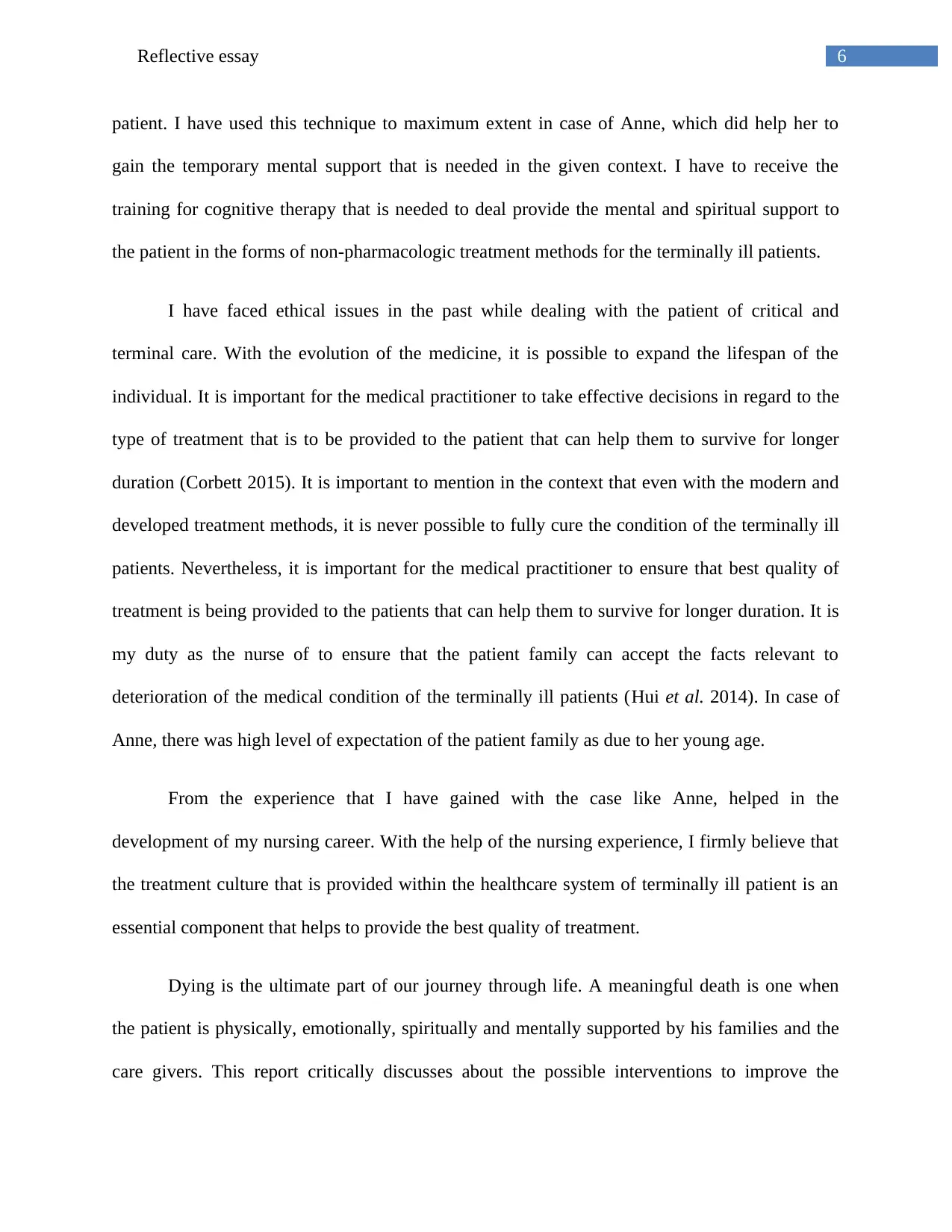
6Reflective essay
patient. I have used this technique to maximum extent in case of Anne, which did help her to
gain the temporary mental support that is needed in the given context. I have to receive the
training for cognitive therapy that is needed to deal provide the mental and spiritual support to
the patient in the forms of non-pharmacologic treatment methods for the terminally ill patients.
I have faced ethical issues in the past while dealing with the patient of critical and
terminal care. With the evolution of the medicine, it is possible to expand the lifespan of the
individual. It is important for the medical practitioner to take effective decisions in regard to the
type of treatment that is to be provided to the patient that can help them to survive for longer
duration (Corbett 2015). It is important to mention in the context that even with the modern and
developed treatment methods, it is never possible to fully cure the condition of the terminally ill
patients. Nevertheless, it is important for the medical practitioner to ensure that best quality of
treatment is being provided to the patients that can help them to survive for longer duration. It is
my duty as the nurse of to ensure that the patient family can accept the facts relevant to
deterioration of the medical condition of the terminally ill patients (Hui et al. 2014). In case of
Anne, there was high level of expectation of the patient family as due to her young age.
From the experience that I have gained with the case like Anne, helped in the
development of my nursing career. With the help of the nursing experience, I firmly believe that
the treatment culture that is provided within the healthcare system of terminally ill patient is an
essential component that helps to provide the best quality of treatment.
Dying is the ultimate part of our journey through life. A meaningful death is one when
the patient is physically, emotionally, spiritually and mentally supported by his families and the
care givers. This report critically discusses about the possible interventions to improve the
patient. I have used this technique to maximum extent in case of Anne, which did help her to
gain the temporary mental support that is needed in the given context. I have to receive the
training for cognitive therapy that is needed to deal provide the mental and spiritual support to
the patient in the forms of non-pharmacologic treatment methods for the terminally ill patients.
I have faced ethical issues in the past while dealing with the patient of critical and
terminal care. With the evolution of the medicine, it is possible to expand the lifespan of the
individual. It is important for the medical practitioner to take effective decisions in regard to the
type of treatment that is to be provided to the patient that can help them to survive for longer
duration (Corbett 2015). It is important to mention in the context that even with the modern and
developed treatment methods, it is never possible to fully cure the condition of the terminally ill
patients. Nevertheless, it is important for the medical practitioner to ensure that best quality of
treatment is being provided to the patients that can help them to survive for longer duration. It is
my duty as the nurse of to ensure that the patient family can accept the facts relevant to
deterioration of the medical condition of the terminally ill patients (Hui et al. 2014). In case of
Anne, there was high level of expectation of the patient family as due to her young age.
From the experience that I have gained with the case like Anne, helped in the
development of my nursing career. With the help of the nursing experience, I firmly believe that
the treatment culture that is provided within the healthcare system of terminally ill patient is an
essential component that helps to provide the best quality of treatment.
Dying is the ultimate part of our journey through life. A meaningful death is one when
the patient is physically, emotionally, spiritually and mentally supported by his families and the
care givers. This report critically discusses about the possible interventions to improve the
Paraphrase This Document
Need a fresh take? Get an instant paraphrase of this document with our AI Paraphraser
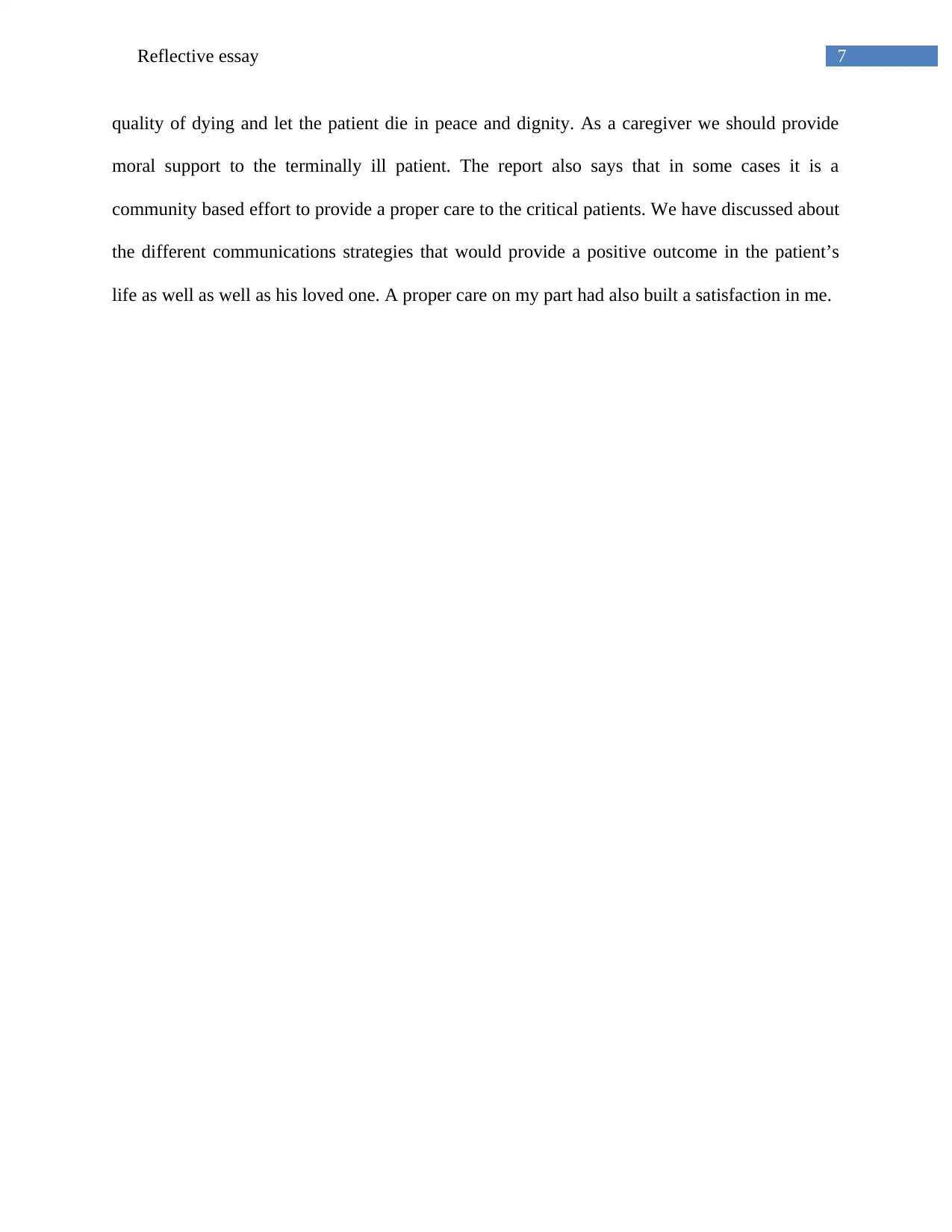
7Reflective essay
quality of dying and let the patient die in peace and dignity. As a caregiver we should provide
moral support to the terminally ill patient. The report also says that in some cases it is a
community based effort to provide a proper care to the critical patients. We have discussed about
the different communications strategies that would provide a positive outcome in the patient’s
life as well as well as his loved one. A proper care on my part had also built a satisfaction in me.
quality of dying and let the patient die in peace and dignity. As a caregiver we should provide
moral support to the terminally ill patient. The report also says that in some cases it is a
community based effort to provide a proper care to the critical patients. We have discussed about
the different communications strategies that would provide a positive outcome in the patient’s
life as well as well as his loved one. A proper care on my part had also built a satisfaction in me.
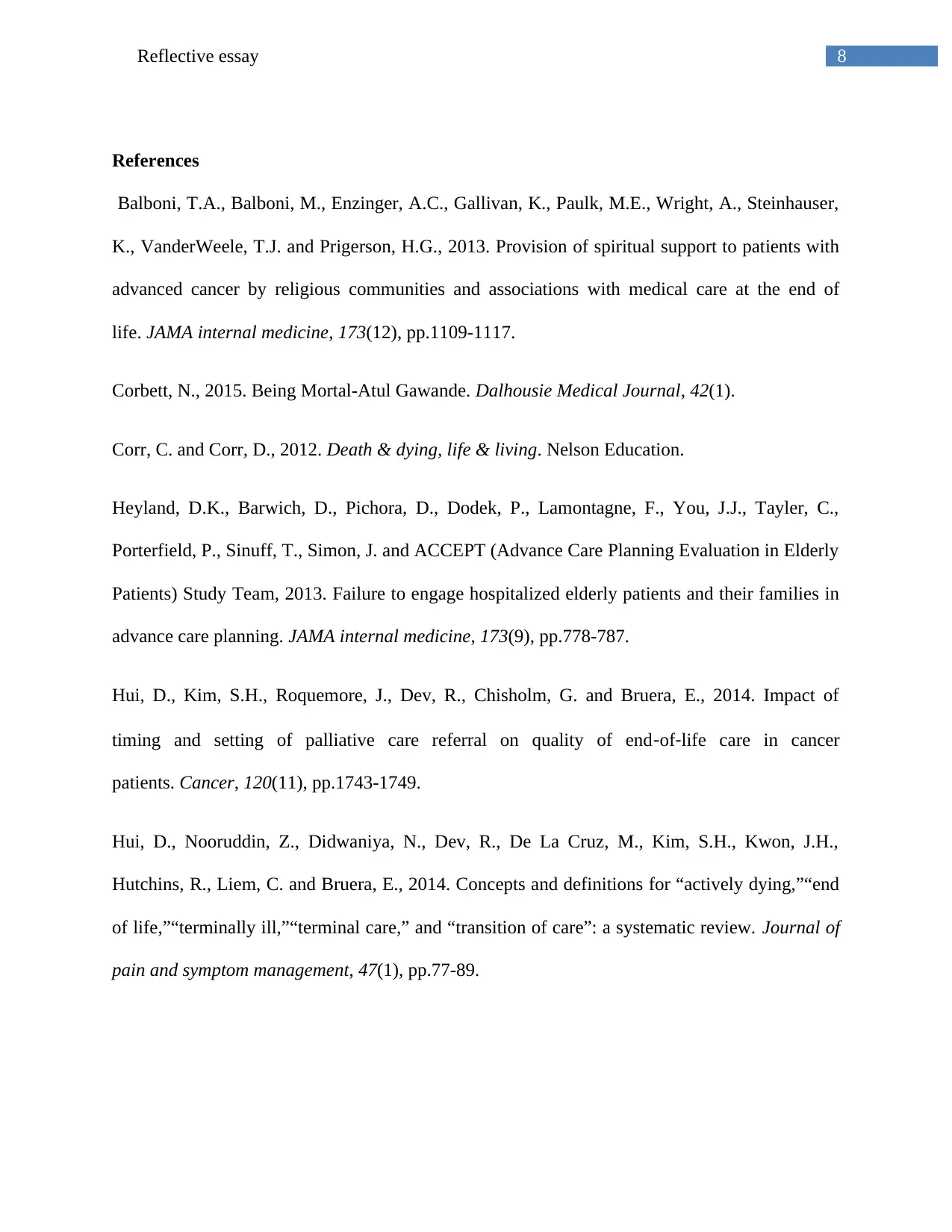
8Reflective essay
References
Balboni, T.A., Balboni, M., Enzinger, A.C., Gallivan, K., Paulk, M.E., Wright, A., Steinhauser,
K., VanderWeele, T.J. and Prigerson, H.G., 2013. Provision of spiritual support to patients with
advanced cancer by religious communities and associations with medical care at the end of
life. JAMA internal medicine, 173(12), pp.1109-1117.
Corbett, N., 2015. Being Mortal-Atul Gawande. Dalhousie Medical Journal, 42(1).
Corr, C. and Corr, D., 2012. Death & dying, life & living. Nelson Education.
Heyland, D.K., Barwich, D., Pichora, D., Dodek, P., Lamontagne, F., You, J.J., Tayler, C.,
Porterfield, P., Sinuff, T., Simon, J. and ACCEPT (Advance Care Planning Evaluation in Elderly
Patients) Study Team, 2013. Failure to engage hospitalized elderly patients and their families in
advance care planning. JAMA internal medicine, 173(9), pp.778-787.
Hui, D., Kim, S.H., Roquemore, J., Dev, R., Chisholm, G. and Bruera, E., 2014. Impact of
timing and setting of palliative care referral on quality of end‐of‐life care in cancer
patients. Cancer, 120(11), pp.1743-1749.
Hui, D., Nooruddin, Z., Didwaniya, N., Dev, R., De La Cruz, M., Kim, S.H., Kwon, J.H.,
Hutchins, R., Liem, C. and Bruera, E., 2014. Concepts and definitions for “actively dying,”“end
of life,”“terminally ill,”“terminal care,” and “transition of care”: a systematic review. Journal of
pain and symptom management, 47(1), pp.77-89.
References
Balboni, T.A., Balboni, M., Enzinger, A.C., Gallivan, K., Paulk, M.E., Wright, A., Steinhauser,
K., VanderWeele, T.J. and Prigerson, H.G., 2013. Provision of spiritual support to patients with
advanced cancer by religious communities and associations with medical care at the end of
life. JAMA internal medicine, 173(12), pp.1109-1117.
Corbett, N., 2015. Being Mortal-Atul Gawande. Dalhousie Medical Journal, 42(1).
Corr, C. and Corr, D., 2012. Death & dying, life & living. Nelson Education.
Heyland, D.K., Barwich, D., Pichora, D., Dodek, P., Lamontagne, F., You, J.J., Tayler, C.,
Porterfield, P., Sinuff, T., Simon, J. and ACCEPT (Advance Care Planning Evaluation in Elderly
Patients) Study Team, 2013. Failure to engage hospitalized elderly patients and their families in
advance care planning. JAMA internal medicine, 173(9), pp.778-787.
Hui, D., Kim, S.H., Roquemore, J., Dev, R., Chisholm, G. and Bruera, E., 2014. Impact of
timing and setting of palliative care referral on quality of end‐of‐life care in cancer
patients. Cancer, 120(11), pp.1743-1749.
Hui, D., Nooruddin, Z., Didwaniya, N., Dev, R., De La Cruz, M., Kim, S.H., Kwon, J.H.,
Hutchins, R., Liem, C. and Bruera, E., 2014. Concepts and definitions for “actively dying,”“end
of life,”“terminally ill,”“terminal care,” and “transition of care”: a systematic review. Journal of
pain and symptom management, 47(1), pp.77-89.
⊘ This is a preview!⊘
Do you want full access?
Subscribe today to unlock all pages.

Trusted by 1+ million students worldwide
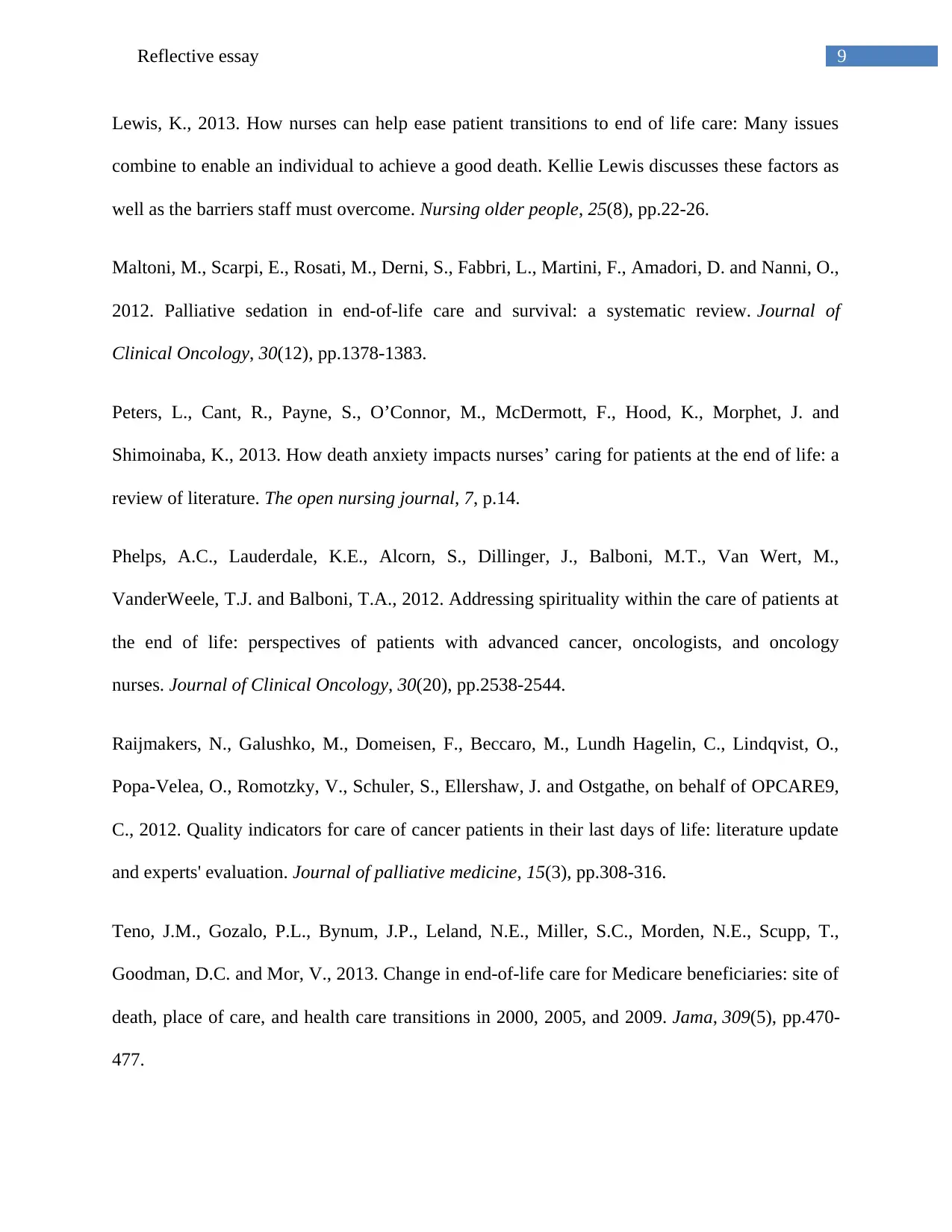
9Reflective essay
Lewis, K., 2013. How nurses can help ease patient transitions to end of life care: Many issues
combine to enable an individual to achieve a good death. Kellie Lewis discusses these factors as
well as the barriers staff must overcome. Nursing older people, 25(8), pp.22-26.
Maltoni, M., Scarpi, E., Rosati, M., Derni, S., Fabbri, L., Martini, F., Amadori, D. and Nanni, O.,
2012. Palliative sedation in end-of-life care and survival: a systematic review. Journal of
Clinical Oncology, 30(12), pp.1378-1383.
Peters, L., Cant, R., Payne, S., O’Connor, M., McDermott, F., Hood, K., Morphet, J. and
Shimoinaba, K., 2013. How death anxiety impacts nurses’ caring for patients at the end of life: a
review of literature. The open nursing journal, 7, p.14.
Phelps, A.C., Lauderdale, K.E., Alcorn, S., Dillinger, J., Balboni, M.T., Van Wert, M.,
VanderWeele, T.J. and Balboni, T.A., 2012. Addressing spirituality within the care of patients at
the end of life: perspectives of patients with advanced cancer, oncologists, and oncology
nurses. Journal of Clinical Oncology, 30(20), pp.2538-2544.
Raijmakers, N., Galushko, M., Domeisen, F., Beccaro, M., Lundh Hagelin, C., Lindqvist, O.,
Popa-Velea, O., Romotzky, V., Schuler, S., Ellershaw, J. and Ostgathe, on behalf of OPCARE9,
C., 2012. Quality indicators for care of cancer patients in their last days of life: literature update
and experts' evaluation. Journal of palliative medicine, 15(3), pp.308-316.
Teno, J.M., Gozalo, P.L., Bynum, J.P., Leland, N.E., Miller, S.C., Morden, N.E., Scupp, T.,
Goodman, D.C. and Mor, V., 2013. Change in end-of-life care for Medicare beneficiaries: site of
death, place of care, and health care transitions in 2000, 2005, and 2009. Jama, 309(5), pp.470-
477.
Lewis, K., 2013. How nurses can help ease patient transitions to end of life care: Many issues
combine to enable an individual to achieve a good death. Kellie Lewis discusses these factors as
well as the barriers staff must overcome. Nursing older people, 25(8), pp.22-26.
Maltoni, M., Scarpi, E., Rosati, M., Derni, S., Fabbri, L., Martini, F., Amadori, D. and Nanni, O.,
2012. Palliative sedation in end-of-life care and survival: a systematic review. Journal of
Clinical Oncology, 30(12), pp.1378-1383.
Peters, L., Cant, R., Payne, S., O’Connor, M., McDermott, F., Hood, K., Morphet, J. and
Shimoinaba, K., 2013. How death anxiety impacts nurses’ caring for patients at the end of life: a
review of literature. The open nursing journal, 7, p.14.
Phelps, A.C., Lauderdale, K.E., Alcorn, S., Dillinger, J., Balboni, M.T., Van Wert, M.,
VanderWeele, T.J. and Balboni, T.A., 2012. Addressing spirituality within the care of patients at
the end of life: perspectives of patients with advanced cancer, oncologists, and oncology
nurses. Journal of Clinical Oncology, 30(20), pp.2538-2544.
Raijmakers, N., Galushko, M., Domeisen, F., Beccaro, M., Lundh Hagelin, C., Lindqvist, O.,
Popa-Velea, O., Romotzky, V., Schuler, S., Ellershaw, J. and Ostgathe, on behalf of OPCARE9,
C., 2012. Quality indicators for care of cancer patients in their last days of life: literature update
and experts' evaluation. Journal of palliative medicine, 15(3), pp.308-316.
Teno, J.M., Gozalo, P.L., Bynum, J.P., Leland, N.E., Miller, S.C., Morden, N.E., Scupp, T.,
Goodman, D.C. and Mor, V., 2013. Change in end-of-life care for Medicare beneficiaries: site of
death, place of care, and health care transitions in 2000, 2005, and 2009. Jama, 309(5), pp.470-
477.
Paraphrase This Document
Need a fresh take? Get an instant paraphrase of this document with our AI Paraphraser
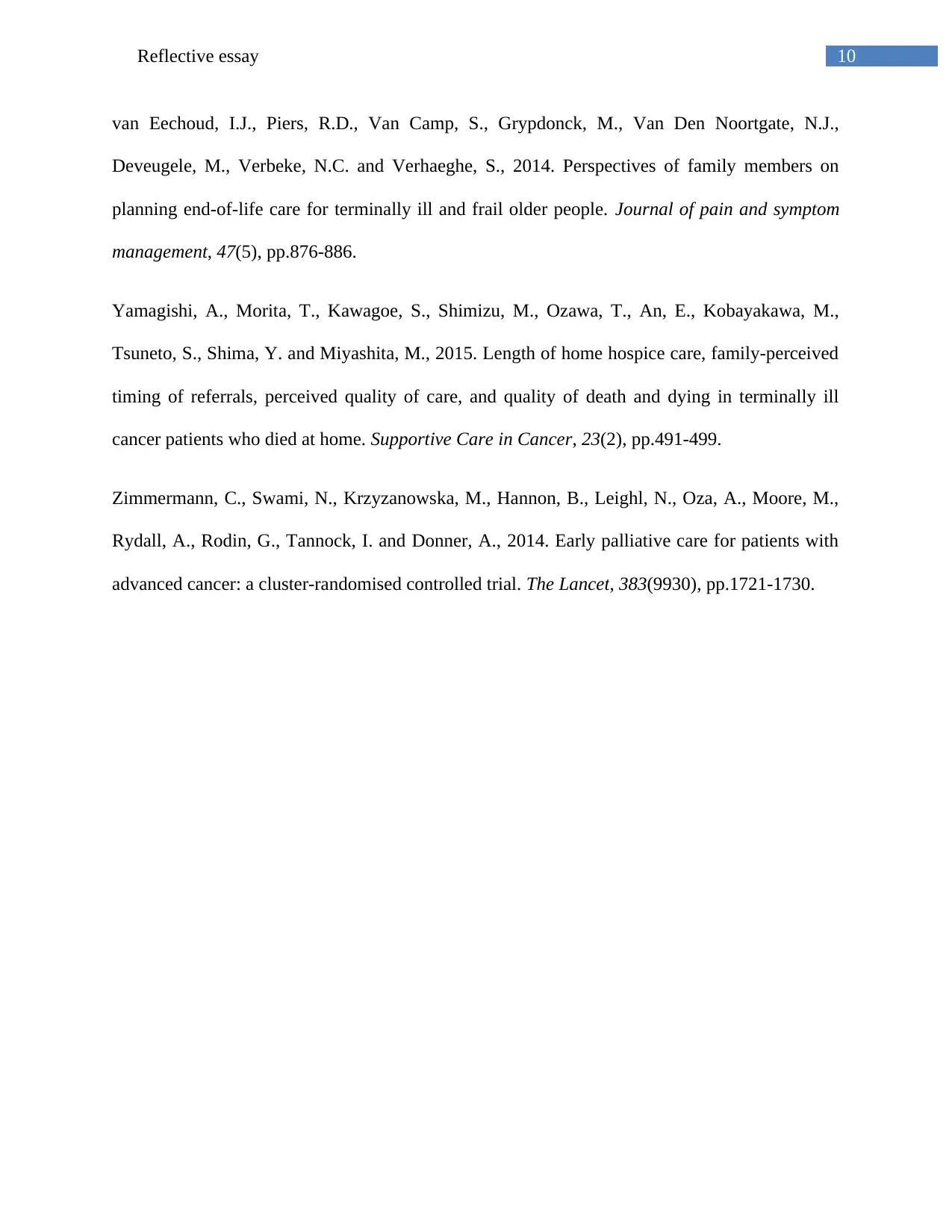
10Reflective essay
van Eechoud, I.J., Piers, R.D., Van Camp, S., Grypdonck, M., Van Den Noortgate, N.J.,
Deveugele, M., Verbeke, N.C. and Verhaeghe, S., 2014. Perspectives of family members on
planning end-of-life care for terminally ill and frail older people. Journal of pain and symptom
management, 47(5), pp.876-886.
Yamagishi, A., Morita, T., Kawagoe, S., Shimizu, M., Ozawa, T., An, E., Kobayakawa, M.,
Tsuneto, S., Shima, Y. and Miyashita, M., 2015. Length of home hospice care, family-perceived
timing of referrals, perceived quality of care, and quality of death and dying in terminally ill
cancer patients who died at home. Supportive Care in Cancer, 23(2), pp.491-499.
Zimmermann, C., Swami, N., Krzyzanowska, M., Hannon, B., Leighl, N., Oza, A., Moore, M.,
Rydall, A., Rodin, G., Tannock, I. and Donner, A., 2014. Early palliative care for patients with
advanced cancer: a cluster-randomised controlled trial. The Lancet, 383(9930), pp.1721-1730.
van Eechoud, I.J., Piers, R.D., Van Camp, S., Grypdonck, M., Van Den Noortgate, N.J.,
Deveugele, M., Verbeke, N.C. and Verhaeghe, S., 2014. Perspectives of family members on
planning end-of-life care for terminally ill and frail older people. Journal of pain and symptom
management, 47(5), pp.876-886.
Yamagishi, A., Morita, T., Kawagoe, S., Shimizu, M., Ozawa, T., An, E., Kobayakawa, M.,
Tsuneto, S., Shima, Y. and Miyashita, M., 2015. Length of home hospice care, family-perceived
timing of referrals, perceived quality of care, and quality of death and dying in terminally ill
cancer patients who died at home. Supportive Care in Cancer, 23(2), pp.491-499.
Zimmermann, C., Swami, N., Krzyzanowska, M., Hannon, B., Leighl, N., Oza, A., Moore, M.,
Rydall, A., Rodin, G., Tannock, I. and Donner, A., 2014. Early palliative care for patients with
advanced cancer: a cluster-randomised controlled trial. The Lancet, 383(9930), pp.1721-1730.
1 out of 11
Related Documents
Your All-in-One AI-Powered Toolkit for Academic Success.
+13062052269
info@desklib.com
Available 24*7 on WhatsApp / Email
![[object Object]](/_next/static/media/star-bottom.7253800d.svg)
Unlock your academic potential
Copyright © 2020–2025 A2Z Services. All Rights Reserved. Developed and managed by ZUCOL.





